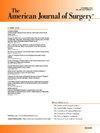结直肠穿孔后弥散性血管内凝血的预测因素
IF 2.7
3区 医学
Q1 SURGERY
引用次数: 0
摘要
目的探讨结直肠穿孔术后弥散性血管内凝血(DIC)与患者预后的关系,探讨术前DIC的预测因素。方法纳入2014年4月至2023年9月期间112例因结直肠穿孔接受急诊手术的患者。我们采用Kaplan-Meier分析评估有和无术后DIC的术后30天生存率,log-rank检验比较生存曲线,logistic回归分析确定术后DIC的术前预测因素。结果术后DIC和30天死亡率分别为37.5%和8%。术后30天死亡率在有DIC的患者和没有DIC的患者之间有显著差异(16.7% vs 2.9%)。术前序贯器官衰竭评估(SOFA)评分是术后DIC的独立预测因素。结论评估术前SOFA评分有助于评估术后DIC风险,有利于结直肠穿孔手术患者早期开始抗凝治疗。本文章由计算机程序翻译,如有差异,请以英文原文为准。
Predictive factors for disseminated intravascular coagulation following colorectal perforation
Purpose
To determine the relationship between postoperative disseminated intravascular coagulation (DIC) and patient prognosis after surgery for colorectal perforation and to identify preoperative predictive factors for DIC.
Methods
We included 112 patients who underwent emergency surgery for colorectal perforation between April 2014 and September 2023. We performed a Kaplan–Meier analysis to assess 30-day postoperative survival with and without postoperative DIC, log-rank test to compare survival curves, and logistic regression analysis to identify preoperative predictive factors for postoperative DIC.
Results
The postoperative DIC and 30-day mortality rates were 37.5 % and 8 %, respectively. The 30-day postoperative mortality rates significantly differed between patients with postoperative DIC and those without (16.7 % vs. 2.9 %). The preoperative Sequential Organ Failure Assessment (SOFA) score was an independent predictive factor for postoperative DIC.
Conclusion
Evaluating preoperative SOFA scores may help assess postoperative DIC risk and enable early initiation of anticoagulant therapy in patients undergoing surgery for colorectal perforation.
求助全文
通过发布文献求助,成功后即可免费获取论文全文。
去求助
来源期刊
CiteScore
5.00
自引率
6.70%
发文量
570
审稿时长
56 days
期刊介绍:
The American Journal of Surgery® is a peer-reviewed journal designed for the general surgeon who performs abdominal, cancer, vascular, head and neck, breast, colorectal, and other forms of surgery. AJS is the official journal of 7 major surgical societies* and publishes their official papers as well as independently submitted clinical studies, editorials, reviews, brief reports, correspondence and book reviews.

 求助内容:
求助内容: 应助结果提醒方式:
应助结果提醒方式:


